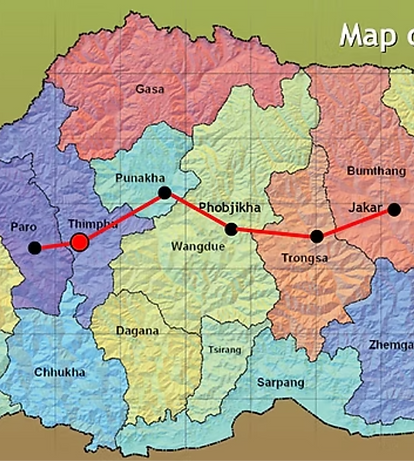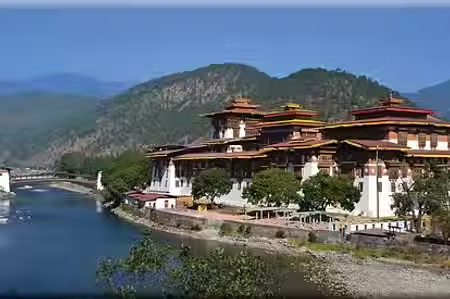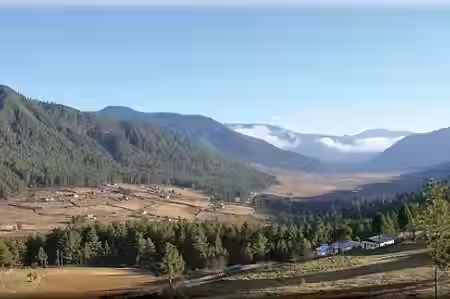

Day 1 Paro-Thimphu
Day 2 Thimphu
Day 3 Thimphu-Punakha
Day 4 Punakha-Bumthang
Day 5 Bumthang
Day 6 Trek
Day 7 Trek
Day 8 Trek
Day 9 Bumthang-Phobjikha
Day 10 Phobjikha-Paro
Day 11 Paro
Day 12 Flight Home

Day 1: Paro (2280m) - Thimphu (2320m)
Overnight in Thimphu.
Our guide will welcome you at the Paro International Airport and thereafter take you on a 90-minute scenic ride to Thimphu. En route, you will visit Tamchog Lhakhang, where you will see the traditional iron bridge.
Lunch will be in Thimphu. For the rest of the day, your tour may include: Buddha Point (where you will have a panoramic view of Thimphu Valley below you), and National Memorial Chorten. If you arrive on a weekend, either Saturday or Sunday, you will have the chance to visit the Centenary Farmers Market and the Weekend Market with the locals selling their produce and handicrafts on both sides of the Wang Chhu.

Day 2: Thimphu (2320m)
Overnight in Thimphu.
After breakfast, you will get to find out more about Thimphu, the capital of Bhutan. Visits will include Folk Heritage Musem, The School of Thirteen Arts & Crafts, Traditional Textile Factory, Traditional Paper Making Factory, and the Thimphu Dzong. The dzong is perhaps the most visibly striking architectural aspect of the kingdom. It was constructed originally as a fortress. But today, the dzong is the administrative and religious centre of the dzongkhag (or district) in Bhutan. You will also get to see the national animal of Bhutan, the takin, at the Motithang Takin Zoo. If you are curious enough, you may also stroll through the streets and roads of Thimphu, the only city in the world without traffic lights, in the evening and do some shopping.

Day 3: Thimphu (2320m) – Dochu La (3140m) – Punakha (1250m)
Overnight in Punakha.
Today, we leave Thimphu and drive uphill to Dochu La, a pass marked by a large array of colourful fluttering prayer flags and the 108 chortens. While you enjoy your cup of tea and snacks, you may also get a panoramic view of the Bhutan Himalayas. Then the drive will continue to Chimi Lhakhang, where you will have your lunch. After lunch, you may take a short hike to the temple on a hillock. This is the Temple of the Divine Mad Monk, where childless Bhutanese pray for fertility. For the rest of the afternoon, you will visit Punakha Dzong, arguably the most beautiful dzong in Bhutan. Nearby the dzong is one of the longest suspension bridges in the country. You may also visit Sangchhen Dorji Lhuendrup Lhakhang Nunnery that is perched on a ridge amid pine trees overlooking the valleys of Punakha and Wangdue Phodrang.

Day 4: Punakha (1250m) – Bumthang (2600m)
Overnight in Bumthang.
We leave Punakha early in the morning heading east toward Central Bhutan. En route, we will stop at Trongsa town, which is situated on a steep ridge and offers spectacular views of the deep valleys surrounding it. We will visit the imposing Trongsa Dzong and Ta Dzong, which was once a watchtower, but today houses the most fascinating museum in Bhutan. Thereafter, it will be a drive winding through forested mountains to Bumthang.
Bumthang is a dzongkhag, which is an administrative and judicial district in Bhutan. There are 20 dzongkhags in Bhutan and Bumthang is one of them. This region is the religious heartland of the country and home to some of its oldest Buddhist temples and monasteries. The dzongkhag comprises four valleys: Ura, Chumey, Tang and Choekhor. Our destination in Bumthang is Chamkhar town with its bustling restaurants and handicraft stores.

Day 5: Bumthang (2600m)
Overnight in Bumthang.
You will spend the entire day visiting the many interesting sites in Bumthang, and en route, immerse yourself in the scenic beauty of this valley: Tamshing Goemba (Temple of the Good Message) – You may try hoisting the cloak of chainmail, which is about 25 kg and made by Pema Lingpa (who established this temple), on to your shoulders and carry it while circumambulating the kora three times. To the Bhutanese, this is considered an auspicious act; Membartsho (Burning Lake) – This is a lovely spot where nature, religion and mythology blur into one; Jambay Lhakhang – a fabulous temple believed to be built in the year 659.
Days 6 - 8: Bumthang Trek

Fairly easy trek
Beautiful valleys
Clear, trout-filled rivers
Ancient temples
Ample spots for rests
Best time: Spring and Autumn

Day 9: Bumthang (2600m) – Phobjikha Valley (2900m)
Overnight in Phobjikha Valley.
Today we head for Phobjikha Valley, a scenic destination that is also one of the most important wildlife preserves in the country. Migratory black-necked cranes stop here for their onward journey from Tibet during the winter months of January and February. You will also take a short (about 2 hours) hike through the beautiful valley amidst junipers and bamboos.

Day 10: Phobjikha Valley (2900m) – Paro (2280)
Overnight in Paro.
After breakfast, you will be driven back to Paro. If time permits, you may wish to stroll through the streets of Paro upon arrival. The main street is lined with colourfully painted wooden shop fronts and restaurants.

Day 11: Paro (2280m)
Overnight in Paro.
This morning, you test your stamina and determination to hike up to the Taktsang Lhakang (3120m). Translated, it means ‘Tiger’s Nest’ and the temple, the holiest in Bhutan, clings to a sheer cliff face 900m above the Paro Valley. It is also the most important icon of Bhutan.

Day 12: Paro (2280m)
You will have to wake early for breakfast before being driven to the Paro International Airport for your early return flight home.


